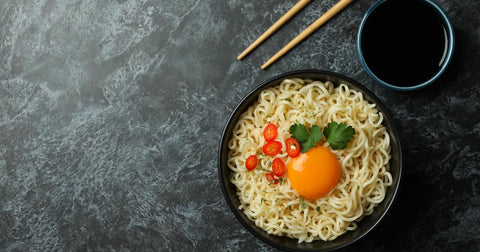Ramen: a culinary comfort, a quick fix, and a college staple. But whispers persist is ramen bad for you? Let's dive deep, separating fact from fiction, and explore the nutritional landscape of this popular dish.

What Are Ramen Noodles Made Of? The Foundation of Flavor
Before we assess the nutritional value, understanding what are ramen noodles made of is crucial. Typically, instant ramen noodles consist of wheat flour, water, salt, and often, kansui – an alkaline mineral water that gives them their distinctive yellow hue and springy texture. This mixture is then pre-cooked, dried (often fried), and packaged with a seasoning packet.
Ramen Noodles Calories: A Quick Energy Boost?
One of the first concerns often raised is the calorie content. Ramen noodles calories can vary significantly depending on the brand and preparation. A single serving of instant ramen can range from 200 to 500 calories, primarily from carbohydrates and fats. While this can provide a quick energy boost, relying on it consistently might not align with long-term health goals.
Is Ramen Healthy? The Nutritional Breakdown

Now, let's tackle the heart of the matter: is ramen healthy? While ramen provides carbohydrates for energy, it often lacks essential nutrients like vitamins, minerals, and fiber. The seasoning packets are frequently high in sodium, artificial flavors, and preservatives.
The Sodium Situation: A Major Concern
High sodium intake is a primary concern with instant ramen. Consuming excessive sodium can contribute to high blood pressure, increasing the risk of heart disease and stroke. This is where the quest for low sodium ramen becomes vital.
Low Sodium Ramen: Healthier Alternatives?
Thankfully, options exist. Seeking out low sodium ramen brands, or preparing ramen from scratch with homemade broth, can significantly reduce sodium intake. Opt for whole-wheat noodles and load up on vegetables for a more balanced meal.
Here are some examples and strategies:
1. Look for "Low Sodium" or "Reduced Sodium" Labels:
-
Many brands offer low-sodium versions of their ramen. These products are specifically formulated to contain significantly less sodium than their regular counterparts. Pay close attention to the nutrition facts panel, as sodium content can vary widely.
2. Explore Specific Brands (with caveats):

-
Lotus Foods: While not strictly "ramen" in the traditional sense, Lotus Foods offers organic rice noodles that can be used in ramen-style dishes. These are naturally lower in sodium than the seasoning packets in many conventional ramen brands.
-
Immi Ramen: This brand focuses on low-carb, high-protein "ramen" alternatives, often with lower sodium content than traditional instant ramen. However, always check the label.
-
Mike's Mighty Good Craft Ramen: Some of their offerings may be lower in sodium than typical instant ramen, but again, careful label reading is essential.
Important Caveats about Brands:
-
Formulations Change: Food manufacturers sometimes change their recipes, so a brand's sodium content can vary.
-
Flavor Packets: The seasoning packets in most ramen are the main source of sodium. Even with lower-sodium noodles, using the entire packet will likely result in a high-sodium meal.
3. The Best Strategy: DIY Ramen
-
The most effective way to control sodium is to make your own ramen from scratch:
-
Noodles: Choose low-sodium noodles (rice noodles, soba noodles, or even zucchini noodles).
-
Broth: Make your own broth using low-sodium chicken or vegetable stock, or water with herbs and spices.
-
Protein: Add lean protein sources like grilled chicken, tofu, or shrimp.
-
Vegetables: Load up on fresh or frozen vegetables like spinach, carrots, and mushrooms.
-
Flavorings: Use herbs, spices, garlic, ginger, and a small amount of low-sodium soy sauce or tamari to create delicious and healthy ramen.
4. Reading the Nutrition Label is Key:

-
Regardless of the brand, always read the nutrition label carefully. Pay close attention to the sodium content per serving and the serving size.
Food Intolerance and Ramen: A Potential Trigger
Beyond the general nutritional profile, some individuals may experience adverse reactions due to food intolerance. Wheat, a primary ingredient, contains gluten, which can be problematic for those with gluten sensitivity or celiac disease. Additionally, certain additives in the seasoning packets might trigger reactions.
Food Sensitivity Test Kit: Uncovering Your Triggers
If you suspect a food intolerance, a food sensitivity test kit can provide valuable insights. These kits help identify specific foods your body might react negatively to, allowing you to make informed dietary choices and avoid potential discomfort.
Navigating Ramen: Tips for Healthier Consumption
-
Choose Wisely: Opt for low-sodium or organic ramen brands.
-
Boost with Veggies: Add plenty of fresh or frozen vegetables like spinach, carrots, and mushrooms.
-
Lean Protein: Include lean protein sources such as chicken, tofu, or eggs.
-
Homemade Broth: Make your own broth using low-sodium ingredients.
-
Limit Seasoning Packet: Use only a portion of the seasoning packet or create your own seasoning blend.
-
Whole Wheat Noodles: If possible, opt for whole wheat noodles for added fiber.
-
Hydration: Drink plenty of water to help flush out excess sodium.
-
Moderation: Enjoy ramen as an occasional treat, not a daily staple.
The Verdict: Ramen in Moderation

So, is ramen bad for you? The answer isn't a simple yes or no. Instant ramen, in its typical form, is not a nutritionally balanced meal. However, by making mindful choices and incorporating healthy additions, you can enjoy ramen without compromising your health.
It is important to understand that everyone's body is different, and what works for one person may not work for another. If you have concerns about your diet and how it affects your health, it is always a good idea to consult with a registered dietitian or healthcare professional.
By understanding the ingredients, calorie content, and potential sensitivities, you can make informed decisions about incorporating ramen into your diet. Remember, moderation and mindful choices are key to enjoying your favorite foods while maintaining a healthy lifestyle.
Frequently Asked Questions:
1. Why is regular ramen so high in sodium?
Regular instant ramen is notoriously high in sodium primarily due to the seasoning packets. These packets often contain a lot of salt, MSG, and other sodium-rich additives for flavor and preservation.
2. Are there any instant ramen brands that are truly low in sodium?
While some brands offer "low-sodium" versions, these may still contain a significant amount of sodium. It's crucial to compare the sodium content per serving on the nutrition label of different brands. Often, even "low-sodium" instant ramen is still much higher in sodium than homemade alternatives.
3. What are some healthy ingredients I can add to ramen to make it more nutritious?
To make ramen healthier, add:
- Lean protein: Chicken, shrimp, tofu
- Plenty of vegetables: Spinach, broccoli, mushrooms, carrots, bean sprouts
- Healthy fats: Avocado, a drizzle of sesame oil
- Fresh herbs: Cilantro, green onions, ginger
4. Are there any types of noodles that are lower in sodium than the typical instant ramen noodles?
Yes, rice noodles, soba noodles (made from buckwheat), and shirataki noodles (made from konjac root) can be lower in sodium than traditional wheat-based instant ramen noodles. However, always check the labels, as sodium content can vary.
5. Is making ramen from scratch difficult?
Making ramen from scratch takes more time than preparing instant ramen, but it's not overly difficult. You can use homemade or low-sodium broth, add fresh ingredients, and control the sodium content. There are many recipes available online for making ramen broth and dishes from scratch.


.png?v=1737390083)
.png?v=1737187409)

